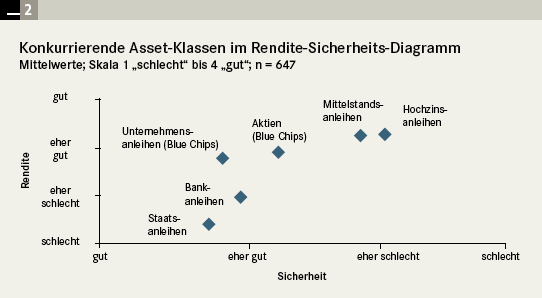The risk associated with bonds: why the asset class is considered safer than commodities or equities
Bonds have different risks depending on the form in which they are structured. Find out which is the biggest risk in bonds and which risks are very manageable here.
Since bonds generally pay interest, which is usually the largest part of the return, and have a fixed repayment date, they are generally considered to be safer than investments with equity characteristics, such as shares. This is because equities and commodities do not have redemption dates and are therefore subject to significantly higher fluctuations in value than bonds.
The following risks can be distinguished for bonds:
- Price risk: effects of a change in market interest rates on the bond price
- Issuer credit risk
- Currency risk (only for foreign currency bonds)
- Liquidity risk
- termination risk

The first risk with bonds: price risk
Bond prices are highly dependent on changes in market interest rates. While the issuer always repays the bond at 100 percent of the nominal value at the end of the term, the market interest rate can influence the price of the bond during the term in one direction or the other. The value of the bond decreases when the interest rate increases. This is because investors can invest the repayment amounts (coupon and redemption) at the new, more attractive interest rate. The change in price and the change in yield are thus opposite. All bonds exhibit price fluctuations. This is relevant for investors who need to sell their bond before maturity or speculate on price gains. If there is a sharp rise in market interest rates, the bond price may also fall below the nominal value of 100 percent, ie below par. If the investor then has to sell, he theoretically makes a loss. However, as the bond is redeemed at par, these interim price declines are of no further significance for investors who hold the bond until final maturity.
The second risk: credit risk of the bond issuer
The issuer's credit risk is also referred to as creditworthiness risk or default risk. This exists if the issuer of a bond defaults on its payments or even becomes insolvent. For the investor, this can mean a partial or complete loss of the invested capital. Thus, the creditworthiness of the issuer is the most important selection criterion for the investor and subsequent creditor when making an investment decision. A good credit rating is intended to ensure that the bond issuer fulfills its contractual obligations. However, a high credit rating is not a guarantee, as the credit rating may change over the years during the term of the bond due to a new business situation or political circumstances. Political causes of credit rating changes can be elections, for example, but macroeconomic changes or company-specific factors can also influence credit ratings. The credit risk of bonds can also be measured by the difference (spread) between the valuation of government bonds on the one hand and the valuation of, for example, corporate bonds on the other.

This chart shows that euro investment grade bond spreads are trading well above their lows. In order to be able to assess changes in the creditworthiness of bonds, the analyzes of rating agencies are available to the private investor. The three largest and best-known agencies are Moody's, Standard & Poor's and Fitch. The rating agencies' analyzes are based on the information provided by the companies to be analyzed and are therefore carried out "ex-post", ie with a time lag. Therefore, the credit rating should be only one criterion in the investment decision.
The 3rd risk of bonds: Currency risk
In the case of bonds denominated in a foreign currency (e.g. US dollar or pound sterling), risks or opportunities may arise from fluctuations in the exchange rate of the foreign currency against the euro. If one owns a US dollar bond whose interest is paid in US dollars, then when the dollar rises against the euro, the credited interest increases in value. There may also be an additional gain when the bond is redeemed if the dollar exchange rate at the time of redemption is higher than it was when the bond was purchased (since you get more euros for the same amount of dollars than before). Otherwise, however, currency losses can occur in exactly the same way. Therefore, this uncertainty is considered a risk. Read more about US bonds in this article from Genève Invest.

Liquidity risk
Liquidity risk refers to the risk that a bond cannot be sold to other investors or can only be sold at a high discount if money is needed before maturity. To minimize liquidity risk, it is advisable to acquire bonds that have already been placed and have a high issue volume.
The final risk of bonds: The termination risk
Many issuers grant themselves an early termination option in the bond terms and conditions in order to reduce the risk of permanently high interest payments. This option is also called a "call". Terminated amounts may only be reinvested at a then prevailing lower interest rate.
Now is the ideal window of opportunity to invest in bonds. Corporate bonds currently offer yields in excess of 7% pa
Arrange a callback from one of our experts now. We advise you free of charge & without obligation and find the best corporate bonds for you.
For investors with €100,000 or more
Free consultation & callback service
Risk and return
Overall, when it comes to the risks of bonds, the basic rule applies once again: the higher the interest rate and yield of the bonds, the higher the risks of this bond investment (probably).
Again and again, the old principle applies: the higher the return, the higher the risk.
Geneve-Invest has been focusing on institutional corporate bonds with high yield and best risk/return ratio for more than 20 years. We strive to balance risk by thoroughly analyzing and constantly monitoring each company. We pay attention to seniority, redemption rates, different maturities in the portfolio, the impact of market fluctuations, and the protection that higher interest rates inherently provide. We also pay attention to maturity to protect our clients' portfolios against inflation and potential interest rate increases

